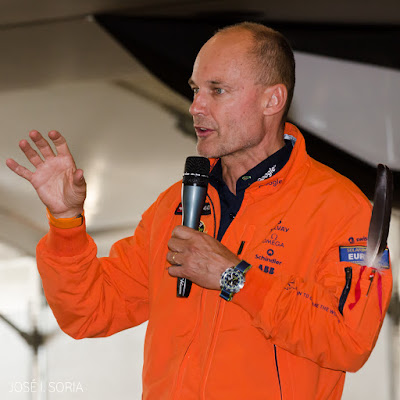Solar Impulse 2 arrives at Seville
NOTA: Para leer esta publicación en otro idioma use el traductor situado a la derecha de la página.
NOTE: To read this post in another language, use the translator located to the right of this page.
Solar Impulse 2 touched down on runway 27 at Seville at 7:38 LT the 23th of June, thus completing the first Atlantic crossing with a solar-powered aircraft, escorted by two Spanish Air Force Eurofighters and the Spanish "Patrulla Águila" aerobatic team.
Bertrand Piccard was the pilot for the New York to Seville segment, which was one of the longest flights of the world tour, lasting over 70 hours.
According to Piccard, everyone involved in this project hopes that the flight symbolized the flight from the "old world" to the "new world".
At the start of 2015, the aircraft was flown to Abu Dhabi, where preparations were made to get SI2 in the air as soon as possible. A mission control center was set up in Monaco.
On the 9th of March it departed Abu Dhabi heading to Muscat, completing the first flight of the RTW tour. Both pilots (Bertrand Piccard and André Borschberg) alternated for each flight.
The longest flight of the RTW tour was the Nagoya-Kalaeola segment, with a flight time of almost 118 hours with Borschberg at the controls. He set a world record for the world's longest solar powered flight by time and also for distance.
The plane's batteries got damaged during that flight, and it was grounded at Hawaii. Flights weren't resumed until April of this year.
Seville-Abu Dhabi is the next scheduled flight with a stop in the way.
NOTE: To read this post in another language, use the translator located to the right of this page.
 |
| Solar Impulse 2 parked inside the hangar. |
Solar Impulse 2 touched down on runway 27 at Seville at 7:38 LT the 23th of June, thus completing the first Atlantic crossing with a solar-powered aircraft, escorted by two Spanish Air Force Eurofighters and the Spanish "Patrulla Águila" aerobatic team.
Bertrand Piccard was the pilot for the New York to Seville segment, which was one of the longest flights of the world tour, lasting over 70 hours.
According to Piccard, everyone involved in this project hopes that the flight symbolized the flight from the "old world" to the "new world".
 |
| A memorable moment as Bertrand Piccard meets André Borschberg after arrival. |
 |
| Bertrand Piccard during the press conference. |
The Solar Impulse project was born in Switzerland in 2003, led by Bertrand Piccard and André Borschberg.
There have been two aicraft built, HB-SIA and the current Solar Impulse 2, HB-SIB.
Solar Impulse 2 has a wingspan of 72 meters, bigger than a 747.
It can go up to 39.000 feet, though the usual crusing altitude is 26.000 feet.
SI2 isn't a very fast aircraft on the other hand, as it just about reachs 70 km/h when cruising. This very light aircraft (2.300 kg) is propelled by 4 electric motors which are powered by the energy of the sun, which is collected by 17.248 solar cells and then stored in 4 lithium-ion batteries.
Flying at night is also possible, as the solar energy stored during the day delivers power to the motors.
SI2 isn't a very fast aircraft on the other hand, as it just about reachs 70 km/h when cruising. This very light aircraft (2.300 kg) is propelled by 4 electric motors which are powered by the energy of the sun, which is collected by 17.248 solar cells and then stored in 4 lithium-ion batteries.
Flying at night is also possible, as the solar energy stored during the day delivers power to the motors.
 |
| The route flown by Solar Impulse 2. Credits to Solar Impulse. |
At the start of 2015, the aircraft was flown to Abu Dhabi, where preparations were made to get SI2 in the air as soon as possible. A mission control center was set up in Monaco.
On the 9th of March it departed Abu Dhabi heading to Muscat, completing the first flight of the RTW tour. Both pilots (Bertrand Piccard and André Borschberg) alternated for each flight.
The longest flight of the RTW tour was the Nagoya-Kalaeola segment, with a flight time of almost 118 hours with Borschberg at the controls. He set a world record for the world's longest solar powered flight by time and also for distance.
The plane's batteries got damaged during that flight, and it was grounded at Hawaii. Flights weren't resumed until April of this year.
Seville-Abu Dhabi is the next scheduled flight with a stop in the way.
You can get updates here.
Special thanks to the Solar Impulse team for allowing me to attend to the event!




Comments
Post a Comment